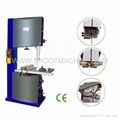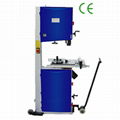| Model: | SHH-1325 |
|---|---|
| Brand: | SHOOT |
| Origin: | Made In China |
| Category: | Industrial Supplies / Tools / Woodworking |
| Label: | woodworking machine , cnc router machine , ATC cnc router machi |
| Price: |
US $35000
/ pc
|
| Min. Order: | 1 pc |
| Last Online:25 Aug, 2025 |
| YANTAI SHOOT WOODWORKING MACHINE CO.,LTD | |
| E-mail: qujun@shootmachine.com,shootmachine@gmail.com | |
| Website: www.shootmachine.com | |
| Tel: +86 535 8949911, 4222377 | |
| Fax: +86 535 8949911, 4314888 | |
| Wechat/Whatsapp/Viber: +86 13906451612, Skype ID: ytmptrade, QQ: 1592903460 | |
| Woodworking Processing Center Automatic Labeling And Automatic Loading And Unloading Router | |
| Features: | |
| The system supports automatic scheduling function | |
| Supports operation buttons at the feeding end | |
| Supports automatic start and stop function of vacuum pump | |
| Model | SHH-1325 |
| Work schedule (X*Y*Z) | 1300*2800*200mm
Can process 48 or 49 feet plates |
| Automatic labeling system | |
| Coding machine | Japanese Itomai industrial coding machine |
| Control system | Taiwan Shindai drive control integrated system |
| Automatic loading and unloading system | |
| Back end | 3 ton electric hydraulic lift |
| Front end | Fully automatic infrared transmission platform |
| Spindle motor | |
| Brand | CC |
| Power | 9KW |
| Cooling method | Air cooling |
| Speed | 6000-24000rpm/min |
| Tool magazine | |
| Working mode | Inline fixed tool magazine |
| Quantity | 16 tools |
| Drilling Package | |
| Number of drill bits | 5+4 9V |
| Drive system | |
| Mode | Servo drive |
| Drive motor | Taiwan AC servo motor 1500W |
| Driver | Taiwan AC servo driver 1500W |
| Frequency Converter | |
| Brand | Yidiantong |
| Power | 11KW |
| Control system | Taiwan Xindai control system (large screen + wireless handwheel) |
| Guide rail | Italy PEK 30 square rail |
| Rack and pinion | Germany high-precision helical gear |
| Reducer | Japan Xinbao 850 |
| Positioning cylinder | 2+3 |
| Wire | High-flexible cable |
| Bed | CNC five-sided milling heavy-duty bed |
| Tabletop | Vacuum adsorption (automatic start and stop function) |
| Pusher | Tabletop secondary dust removal during pushing process |
| Vacuum Pump | |
| Brand | SHOOT Special |
| Power | 7.5KW |
| Cooling | Water circulation |
| Vacuum cleaner | |
| Brand | Haosen |
| Power | 4.0KW |
| No-load speed | |
| X-axis | 80m/min |
| Y-axis | 80m/min |
| Z-axis | 15m/min |
| Processing speed | |
| X-axis | 20m/min |
| Y-axis | 20m/min |
| Z-axis | 10m/min |
| Power type | 380V 50/60HZ |
| Total power (approx.) | about 25KW |
| Look Machine Video,click the Youtube website: | |
| https://youtu.be/kRCQhiFa-mU | |











